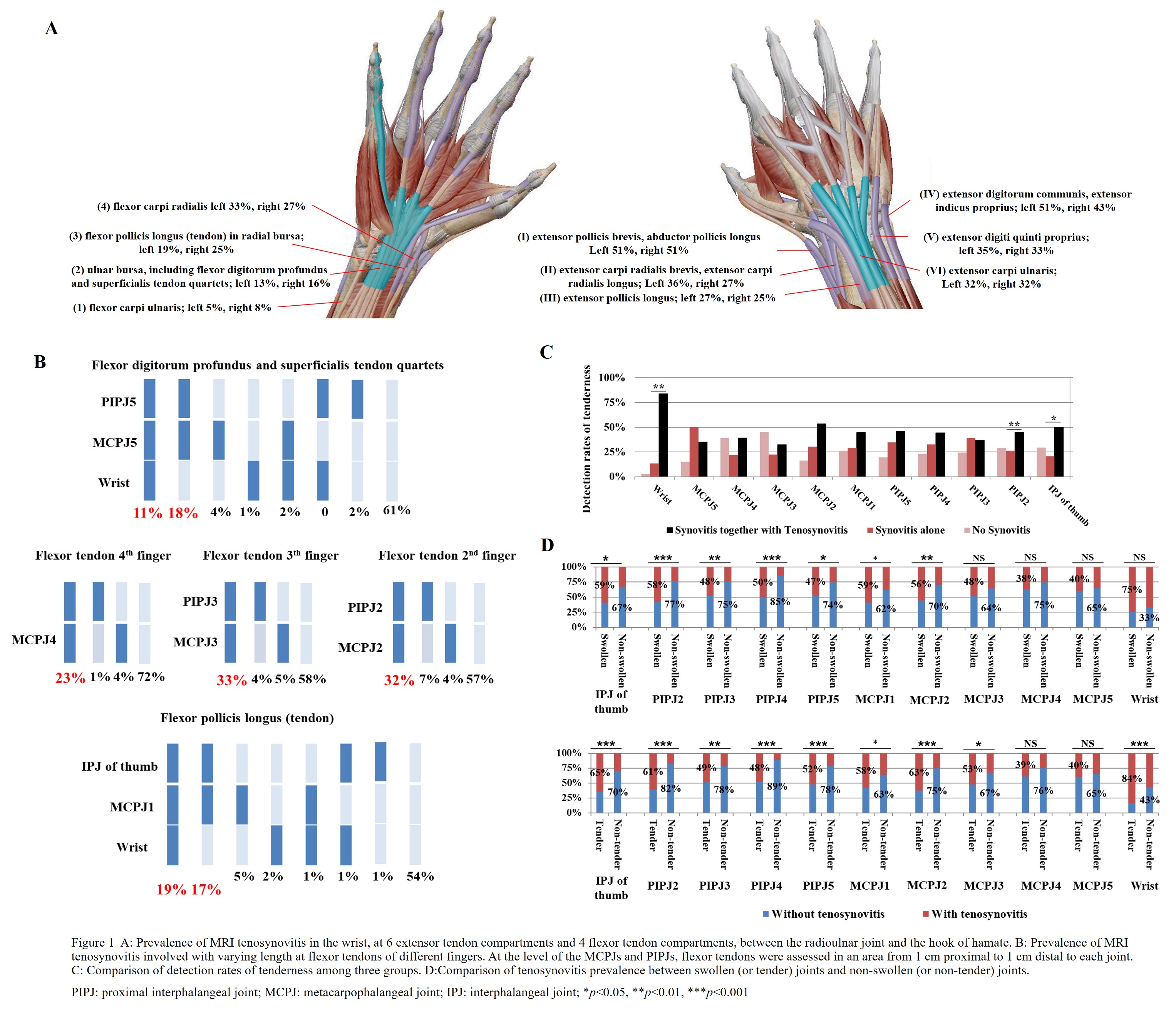Session Information
Session Type: ACR Poster Session A
Session Time: 9:00AM-11:00AM
Background/Purpose: The updated recommendations of Rheumatoid Arthritis Magnetic Resonance Imaging Scoring (RAMRIS) System in 2017 firstly recommended tenosynovitis with a standard score. However, there is no study on the novel score of tenosynovitis using bilateral-hands MRI and no data of MRI tenosynovitis on proximal interphalangeal joints (PIPJs) either.
Objective: To explore the distribution of MRI tenosynovitis among bilateral hands and its concordance with joint swelling/tenderness in early RA patients.
Methods: Early active RA patients (DAS28-CRP¡Ý2.6 and disease duration ¡Ü1 year) were recruited in our hospital during October, 2011 to March, 2018. Bilateral hands (including PIPJs, MCPJs and wrists) of each patient were scanned simultaneously on 3.0T whole-body MRI system with an 8-channel sense head coil. MRI tenosynovitis and synovitis were scored based on RAMRIS 2017. Clinical data were collected simutaneously.
Results:
1. Among 75 patients recruited, the median age was 45 years old with 71% female. The median disease duration was 7 months and 85% had bony erosions.
2. MRI tenosynovitis was detected in 84% of patients. Tenosynovitis in extensors occurred in 72% of wrists, which were higher than tenosynovitis in flexors (52%), of which the most frequent tenosynovitis was detected in extensor pollicis brevis, abductor pollicis longus (figure 1A). Tenosynovitis occurred alone or together with synovitis. For wrists, interphalangeal joints (IPJ) of thumb and PIPJ2, joints with both synovitis and tenosynovitis showed higher rates of tenderness than those joints with synovitis alone (p<0.05, figure 1C).
3. For PIPJ2-5 and IPJ of thumb, the prevalence of tenosynovitis in swollen (or tender) joints were significantly higher than those in non-swollen (or non-tender) joints (all p<0.05, figure 1D). Multivariate Logistics regression analyses showed MRI tenosynovitis score was an independent risk factor respectively for swelling (or tenderness) of PIPJ2, PIPJ4, PIPJ5; tenderness of MCPJ1~4 and IPJ of thumb (OR 1.859~3.414, all p<0.05).
4. Tender wrists showed more tendon sheaths with tenosynovitis than non-tender wrists (3.6¡À3.1 vs. 2.3¡À2.9, p=0.007). ROC analyses showed that when there were ¡Ý3 tendon sheaths with tenosynovitis, tenderness occurred in the wrist with 54% of sensitivity and 66% of specificity (AUC: 0.647, 95%CI: 0.559-0.735, p=0.002). Tenosynovitis score of flexor carpi radialis tendon was an independent risk factor for tenderness of wrists (OR 2.050, 95%CI: 1.103-3.812, p=0.023).
Conclusion:
This study first reports distribution of MRI tenosynovitis among bilateral hands including PIPJs, and tenosynovitis score was an independent risk factor for tenderness of wrist, certain MCPJs or PIPJs.
Funding: Yat-Sen Scholarship for Young Scientists.
To cite this abstract in AMA style:
Mo YQ, Yang ZH, Wang JW, Du XY, Xu YH, Yang KM, Shi GZ, Shen J, Dai L. Tenosynovitis on MRI of Bilateral Hands and Its Concordance with Joint Swelling/Tenderness in Patients with Early Rheumatoid Arthritis [abstract]. Arthritis Rheumatol. 2018; 70 (suppl 9). https://acrabstracts.org/abstract/tenosynovitis-on-mri-of-bilateral-hands-and-its-concordance-with-joint-swelling-tenderness-in-patients-with-early-rheumatoid-arthritis/. Accessed .« Back to 2018 ACR/ARHP Annual Meeting
ACR Meeting Abstracts - https://acrabstracts.org/abstract/tenosynovitis-on-mri-of-bilateral-hands-and-its-concordance-with-joint-swelling-tenderness-in-patients-with-early-rheumatoid-arthritis/

